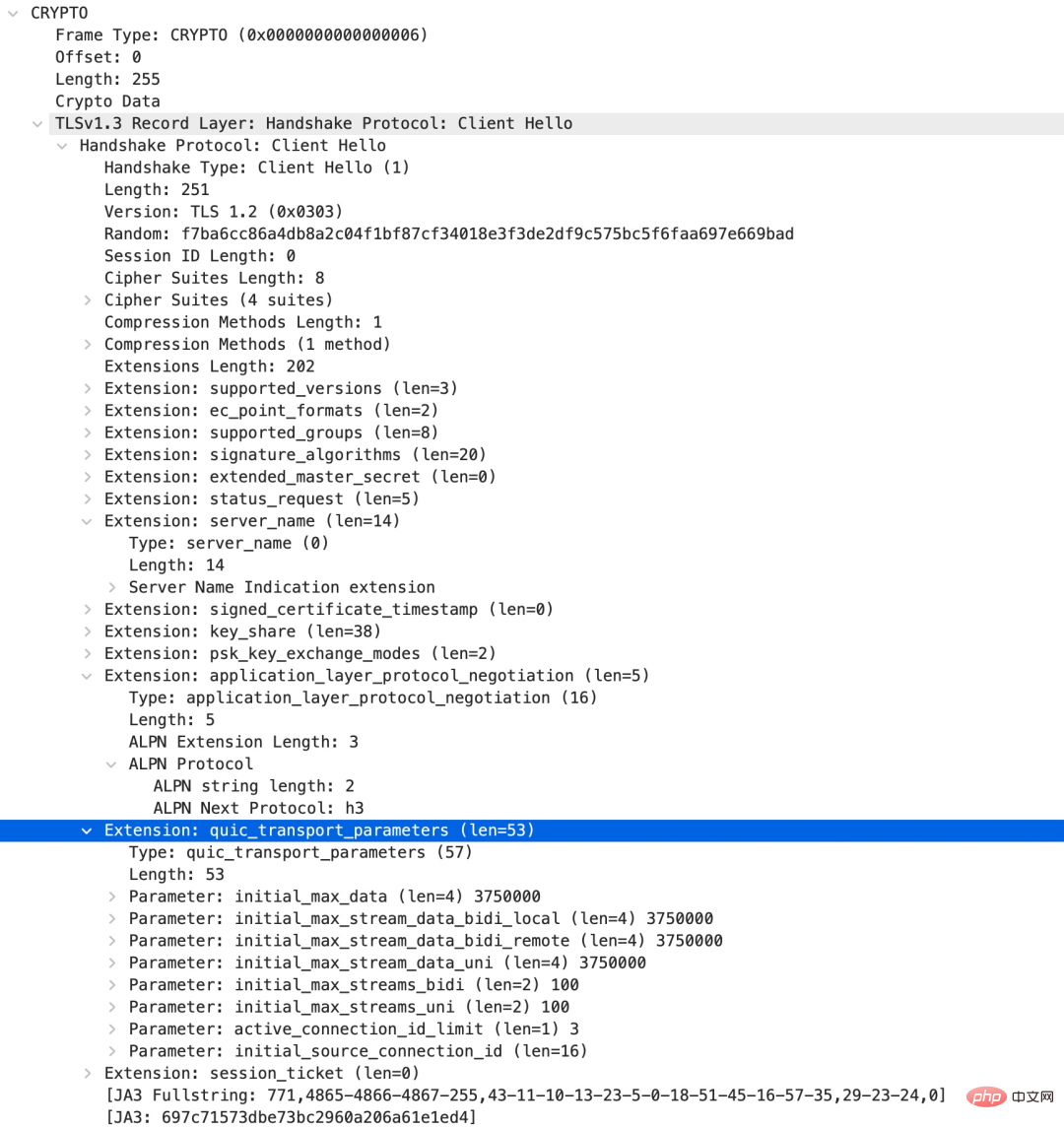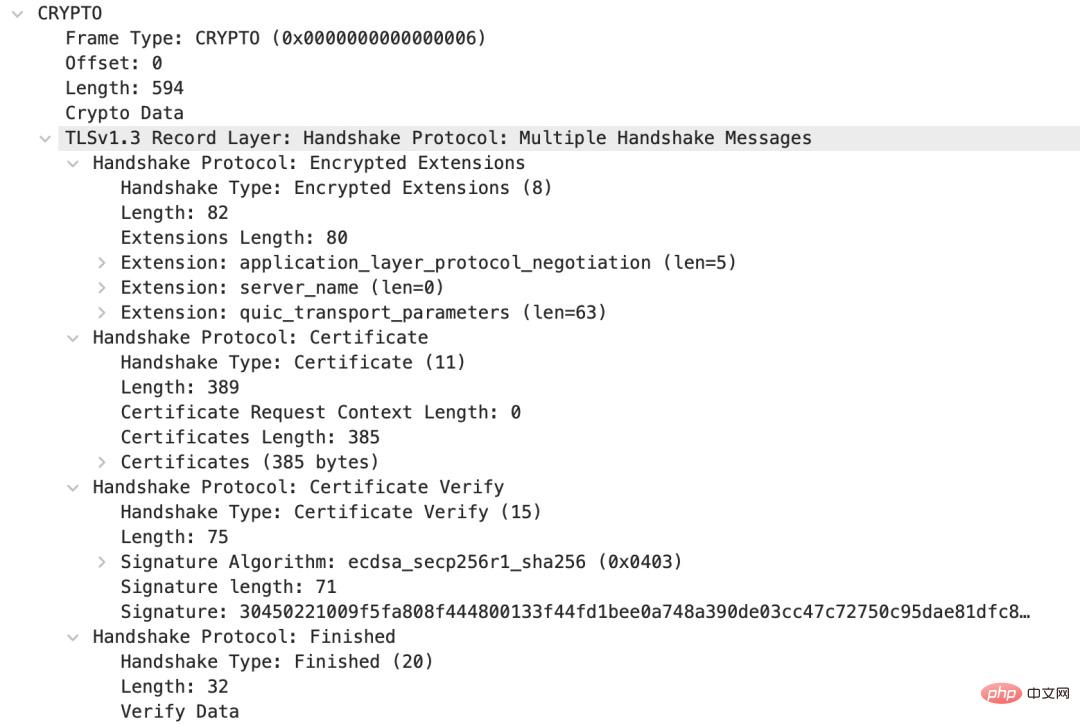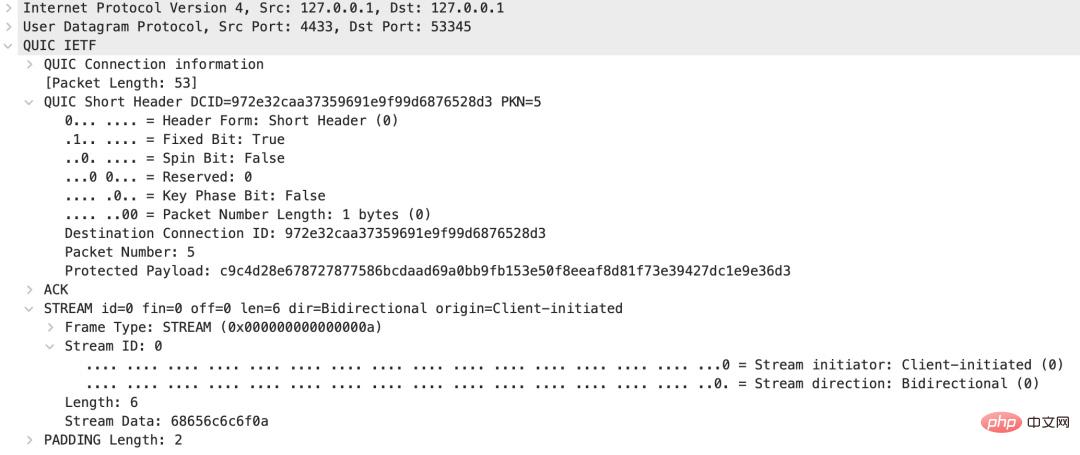 Operation and Maintenance
Operation and Maintenance
 Safety
Safety
 Let's see how to learn network protocols through the QUIC protocol
Let's see how to learn network protocols through the QUIC protocol
Let's see how to learn network protocols through the QUIC protocol
This article will take you to understand the QUIC protocol, and take the QUIC protocol as an example to talk about how to learn network protocols. I hope it will be helpful to everyone!

In a previous article about s2n-quic, a reader asked me how to learn a network protocol like QUIC. For most Internet practitioners, although they deal with the Internet every day, few people care about the details of the network protocol under HTTP. Most of the time, it is enough to have a general understanding and know how to use it. . If you have no idea about QUIC, then the following picture can help you have a good understanding of QUIC’s position in the HTTP/3 ecosystem:

So, if you I just want to learn more about QUIC. How to get started?
As a former developer of network protocols and network equipment, my own experience is: start with RFC, supplemented by wireshark packet capture, to quickly master the target protocol.
For QUIC, the first thing we need to read is RFC9000. Reading the agreement is very boring and requires a certain amount of patience. If your English is not very good, you can use Google Translate to translate it into Chinese and browse it quickly (extensive reading). The first reading is mainly to understand the main concepts and main processes.
After that, we can write a program using the QUIC protocol, and then capture the packets through wireshark. By studying the actual messages and comparing them with the contents of the RFC protocol (intensive reading), we can gain a deeper understanding of the essence of the protocol.
We still build the echo client and server based on the code in the previous article. To make it easier for everyone to read, I've also posted the code. Interested students can clone my repo and run the client/server code.
Client code (see github: tyrchen/rust-training/live_coding/quic-test/examples/client.rs):

Server code (see github: tyrchen/rust-training/live_coding/quic-test/examples/server.rs):

These two pieces of code build the simplest echo server. We can use wireshark to monitor UDP packets under the local loopback interface and capture packets. It should be noted that for traffic using the TLS protocol like QUIC, even if the packets are captured, only the first few packets may be readable, and subsequent packets are encrypted and cannot be read. Therefore, when we build client/server, we need to find a way to capture the session key negotiated between the server and the client for wireshark to decrypt. Generally, SSL/TLS libraries provide this function. For example, for Rustls, we can use key_log in tls config. If you look carefully at the server code above, you will see this sentence:
let config = Builder::new()
.with_certificate(CERT_PEM, KEY_PEM)?
.with_key_logging()? # 使能 keylogging
.build()?;After using key_log, when starting the server, we only need to specify SSLKEYLOGFILE:
SSLKEYLOGFILE=session.log cargo run --example server
In After the packet capture is completed, open the wireshark preference, select the TLS protocol, and put the log path in:

The following is a complete interaction between the client and the server Capturing the packet, we see that all "protected payloads" are displayed normally:

Because our echo client only does the simplest action (only opens A bidirectional stream), so through this packet capture, we can focus on studying the process of establishing a connection by the QUIC protocol.
The first packet sent by the client
Let’s look at the first packet sent by the client:

This message contains very rich information. First of all, unlike the TCP handshake, the first packet of QUIC is very large, as much as 1200 bytes (the protocol requires UDP payload at least 1200 bytes), including the QUIC header, a 255-byte CRYPTO frame, and 890-byte PADDING frame. As you can see from the header, the type of this QUIC package is Initial.
QUIC message type
For QUIC packets, the Header is plain text, and all subsequent frame payloads are ciphertext (except for the header several packages). We see that this first packet is a Long Header message. In Section 17.2 of RFC9000, Long Header Packet is defined:
Long Header Packet {
Header Form (1) = 1,
Fixed Bit (1) = 1,
Long Packet Type (2),
Type-Specific Bits (4),
Version (32),
Destination Connection ID Length (8),
Destination Connection ID (0..160),
Source Connection ID Length (8),
Source Connection ID (0..160),
Type-Specific Payload (..),
}If you are interested, you can read the corresponding chapter of RFC by yourself. For Long Header messages, there are the following types:

既然有 Long Header packet,那么就有 Short Header packet,Short Header packet 目前的版本只有一种:
1-RTT Packet {
Header Form (1) = 0,
Fixed Bit (1) = 1,
Spin Bit (1),
Reserved Bits (2),
Key Phase (1),
Packet Number Length (2),
Destination Connection ID (0..160),
Packet Number (8..32),
Packet Payload (8..),
}为什么需要 connection id?
在我们捕获的这个报文头中,我们看到有 Source Connection ID(SCID)和 Destination Connection ID(DCID)这个新的概念。你也许会好奇:QUIC 不是基于 UDP/IP 的协议么?底层的协议已经有五元组(src ip / src port / dst ip / dst port / protocol)来描述一个连接(connection),为什么还需要 connection id 这样一个新的概念?
这是为了适应越来越多的移动场景。有了 QUIC 层自己的 connection id,底层网络(UDP/IP)的变化,并不会引发 QUIC 连接的中断,也就是说,你从家里开车出门,即便手机的网络从 WIFI(固网运营商分配给你的 IP)切换到蜂窝网络(移动运营商分配给你的 IP),整个 UDP/IP 网络变化了,但你的 QUIC 应用只会感受到细微的延迟,并不需要重新建立 QUIC 连接。
从这个使用场景来看,QUIC 底层使用无连接的 UDP 是非常必要的。
首包中就包含了 TLS hello?
我们接下来看看 CRYPTO frame:

可以看到,QUIC 在建立连接的首包就把 TLS Client Hello 囊括在 CRYPTO frame 中。并且使用的 TLS版本是 1.3。在 Client Hello 的 extension 中,QUIC 协议使用了一个 quic_transport_parameters 的 extension,用来协商 QUIC 自己的一些初始值,比如支持多少个 stream,这个连接中可以最多使用多少个 active connection id 等等。
QUIC 支持哪些 frame?
现在我们已经见到了两种 Frame:CRYPTO 和 PADDING。下表中罗列了 QUIC 所有支持的 frame:

服务器的回包
我们来看 server 的回包:

这里有一些新东西。首先,一个 UDP 包内部可以包含若干个 QUIC payload,我们看到 server 回复了一个 QUIC Initial 报文和一个 QUIC Handshake 报文。在 Initial 报文中,我们看到了一个 ACK frame,可见 QUIC 虽然构建于 UDP,但在 QUIC 协议内部构建了类似 TCP 的确认机制。
我们之前看到,在 Initial 报文的 CRYPTO frame 中,客户端发送了 TLS Client Hello,同样的,服务器在 Initial 报文的 CRYPTO frame 中发送了 TLS Server Hello。这个我们就略过不看。
在 Handshake 报文中:

服务器发送了自己的证书,并结束了 TLS handshake。
客户端结束 Handshake
我们再看第三个包,客户端发送给服务器结束 TLS 握手:

这个包依旧包含两个 QUIC 报文,其中第一个就是一个 ACK frame,来确认收到了服务器的 Server Hello 那个 QUIC 报文;第二个包含一个 ACK frame,确认服务器的 Handshake,随后有一个 CRYPTO frame 结束客户端的 TLS handshake。
TLS 握手结束之后,客户端和服务器就开始应用层的数据交换,此刻,所有数据都是加密的。
客户端发送一个 “hello” 文本
在我们的 echo client/server 代码中,客户端连接到服务器后,就可以等待用户在 stdin 的输入,然后将其发送到服务器。服务器收到客户端数据,原封不动发回,客户端再将其显示到 stdout 上。在这个过程的前后,客户端和服务器间有一些用于连接管理的 QUIC 报文,比如 PING。我们就略过,只看发送应用层数据的报文。下图是客户端发送的包含 “hello” 文本的报文:

As you can see, the QUIC message here is a Short Header packet. In addition to the ACK frame, it also has a STREAM frame. The lowest two digits of the stream ID of this stream are 00, which represents a client-initiated, bidirectional stream. Since two bits are used to express the type, QUIC's stream has the following types:

We look at the length(6) and Data(68 65 6c 6c 6f 0a of the STREAM frame ). If the content in Data is expressed in ASCII, it is exactly "hello
The server replies "hello" text
Finally the server echo back:

This is exactly the same as the above message, so I won’t explain it.
Sage Moment
I believe that the above introduction to QUIC based on the wireshark packet capture can give you a preliminary understanding of the QUIC protocol. know. In the last article, we said that QUIC supports multiplexing and solves the problem of head-of-queue blocking at the transport layer. Through the introduction of this article, can you answer the following two questions?
Which frame type does QUIC use for multiplexing?
QUIC How to solve the problem of head-of-queue blocking at the transport layer?
Related recommendations: web server security
The above is the detailed content of Let's see how to learn network protocols through the QUIC protocol. For more information, please follow other related articles on the PHP Chinese website!

Hot AI Tools

Undresser.AI Undress
AI-powered app for creating realistic nude photos

AI Clothes Remover
Online AI tool for removing clothes from photos.

Undress AI Tool
Undress images for free

Clothoff.io
AI clothes remover

Video Face Swap
Swap faces in any video effortlessly with our completely free AI face swap tool!

Hot Article

Hot Tools

Notepad++7.3.1
Easy-to-use and free code editor

SublimeText3 Chinese version
Chinese version, very easy to use

Zend Studio 13.0.1
Powerful PHP integrated development environment

Dreamweaver CS6
Visual web development tools

SublimeText3 Mac version
God-level code editing software (SublimeText3)

Hot Topics
 1386
1386
 52
52
 Which protocol does vivo fast charging belong to?
Sep 06, 2022 pm 02:43 PM
Which protocol does vivo fast charging belong to?
Sep 06, 2022 pm 02:43 PM
There are two main protocols for vivo fast charging: 1. "QC 2.0" fast charging protocol. "QC2.0" is "Quick Charge 2.0" technology. It is version 2.0 of fast charging technology released by Qualcomm. It can output 5V, 9V, and 12V. , 20V four voltage groups; 2. PD fast charging protocol is a fast charging specification formulated by the "USB-IF" organization. It is one of the current mainstream fast charging protocols and can make the current default maximum power "5V/2A" The "type-c" interface is increased to 100W.
 What is the maximum watt of PD3.0 fast charging protocol?
Nov 08, 2022 pm 04:04 PM
What is the maximum watt of PD3.0 fast charging protocol?
Nov 08, 2022 pm 04:04 PM
The PD3.0 fast charging protocol supports up to “100W”. In November 2015, USB PD fast charging ushered in a major version update, entering the USB PD3.0 fast charging era; the PD3.0 protocol supports 5V3A, 9V3A, 12V3A, 15V3A, 20V5A output, and the maximum power can reach 100W. Not only can It can be used to charge mobile phones, and can also be used to power laptops or monitors.
 What are the 5 industrial communication protocols?
Sep 28, 2022 am 11:52 AM
What are the 5 industrial communication protocols?
Sep 28, 2022 am 11:52 AM
5 types of industrial communication protocols: 1. Modbus protocol, which is a universal language used in electronic controllers; 2. RS-232 protocol, which is a serial physical interface standard; 3. RS-485 protocol, which is based on RS232 Developed on the basis of; 4. HART protocol is a communication protocol used between on-site intelligent instruments and control room equipment; 5. MPI protocol is a cross-language communication protocol used to write parallel computers.
 What are the network protocols in Go language?
Jun 10, 2023 pm 02:06 PM
What are the network protocols in Go language?
Jun 10, 2023 pm 02:06 PM
In recent years, Go language, as an efficient, lightweight, and excellent concurrency programming language, has attracted more and more people's attention and love. In terms of network programming, the Go language has rich network protocol support and can help developers build network applications quickly and conveniently. Let's take a look at the network protocols in Go language. 1.TCPTCP (TransmissionControlProtocol, Transmission Control Protocol) is a transmission protocol commonly used in computer networks.
 What are the common protocols for Java network programming?
Apr 15, 2024 am 11:33 AM
What are the common protocols for Java network programming?
Apr 15, 2024 am 11:33 AM
Commonly used protocols in Java network programming include: TCP/IP: used for reliable data transmission and connection management. HTTP: used for web data transmission. HTTPS: A secure version of HTTP that uses encryption to transmit data. UDP: For fast but unstable data transfer. JDBC: used to interact with relational databases.
 SOAP Protocol Guide in PHP
May 20, 2023 pm 07:10 PM
SOAP Protocol Guide in PHP
May 20, 2023 pm 07:10 PM
With the continuous development of Internet technology, more and more enterprise-level applications need to provide interfaces to other applications to realize the interaction of data and business. In this case, we need a reliable protocol to transmit data and ensure data integrity and security. SOAP (Simple Object Access Protocol) is an XML-based protocol that can be used to implement communication between applications in a Web environment. As a popular web programming language, PHP
 What is the qc4+ fast charging protocol?
Aug 18, 2022 pm 03:49 PM
What is the qc4+ fast charging protocol?
Aug 18, 2022 pm 03:49 PM
The QC4+ fast charging protocol is a combination of the USB PD PPS protocol and the QC3.0/2.0 fast charging protocol. It is a multi-functional, multi-protocol fast charging technology. The QC4+ charging protocol is compatible with USB PD3.0 (PPS) and is downwardly compatible with USB PD2.0, QC3.0, QC2.0, BC1.2 and other protocols. The first prerequisite for supporting USB PD and QC4+ is the support of USB-C interfaces at both ends and the power negotiation message based on the CC (configuration channel) in the USB-C interface.
 What are the three elements of network protocols?
Dec 09, 2020 am 10:23 AM
What are the three elements of network protocols?
Dec 09, 2020 am 10:23 AM
The three elements of the network protocol: 1. Semantics, which explains the meaning of each part of the control information; it stipulates what kind of control information needs to be sent, as well as the completed actions and what kind of responses should be made. 2. Grammar, that is, the structure and format of user data and control information, and the order in which data appears. 3. Timing, that is, a detailed description of the sequence of events.



